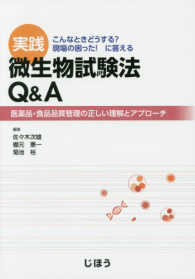Full Description
This book analyzes the creation of languages across the Slavophone areas of the world and their deployment for political projects and identity building, mainly after 1989. It offers perspectives from a number of disciplines such as sociolinguistics, socio-political history and language policy.
Languages are artefacts of culture, meaning they are created by people. They are often used for identity building and maintenance, but in Central and Eastern Europe they became the basis of nation building and national statehood maintenance. The recent split of the Serbo-Croatian language in the wake of the break-up of Yugoslavia amply illustrates the highly politicized role of languages in this region, which is also home to most of the world's Slavic-speakers. This volume presents and analyzes the creation of languages across the Slavophone areas of the world and their deployment for political projects and identity building, mainly after 1989. The overview concludes with a reflection on the recent rise of Slavophone speech communities in Western Europe and Israel. The book brings together renowned international scholars who offer a variety of perspectives from a number of disciplines and sub-fields such as sociolinguistics, socio-political history and language policy, making this book of great interest to historians, sociologists, political scientists and anthropologists interested in Central and Eastern Europe and Slavic Studies.
Contents
1. Cross-border Turkic and Iranian Language Retention in the West and East Slavic Lands and Beyond: A Tentative Classification; Paul Wexler 2. Identity and Language of the Roma (Gypsies) in Central and Eastern Europe; Elena Marushiakova and Vesselin Popov PART I: NORTH SLAVS AND THEIR LANGUAGES 3. The Polish Livonian Legacy in Latgalia:The Confluence of Slavic Ethnolects in the Baltic-Slavic Borderland; Catherine Gibson 4. Iazychie and Surzhyk: Mixing Languages and Identities in the Ukrainian Borderlands; Andrii Danylenko 5. A Borderland of Borders: The Search for a Literary Language in Carpathian Rus; Paul Robert Magocsi 6. Rusyn: A New-Old Language In-Between Nations and States; Michael Moser 7. The Czech-Slovak Communicative and Dialect Continuum: With and Without a Border; Mira Nabelkova 8. The Changing Lattice of Languages, Borders and Identities in Silesia; Tomasz Kamusella 9. 'Our people is divided, yes, and torn asunder...' The Sorbian Language Community and Its Internal Divisions; Roland Marti 10. Fickle Nationalism and Slovakia's Shifting Ethno-Linguistic Borders; Alexander Maxwell 11. From 'Hungarus' Patriotism to Linguistic Nationalism; Istvan Fried PART II: SOUTH SLAVS AND THEIR LANGUAGES 12. Phonology and the Construction of Borders in the Balkans; Brian Joseph 13. Slovene Language after the Schengen Agreement: Will the Linguistic Borders Also Disappear; Andrej Bekes 14. Borderlands and Transborder Regions of the Croatian Literary Language: How Far Back in History Is Enough?; Anita Peti-Stantic and Keith Langston 15. The Language Situation for the Bosniaks on Both Sides of the Serbian/Montenegrin Border; Robert Greenberg 16. Burgenland Croatian: An Old Language on a Do-It-Yourself Border with a New Name; E Wayles Browne 17. Identity Problems of the Goranians in Eastern Albania and Kosovo; Klaus Steinke 18. Borders in Bulgaria in the Light of Areal Ethnolinguistics; Irina Sedakova 19. The Rise, Fall, and Revival of the Banat Bulgarian Language: Sociolinguistic History fro the Perspective of Trans-Border Interactions; Motoki Nomachi 20. Conflicting Discourses in the Balkan Slavic Language Area; Jouko Lindstedt PART III: A GLIMPSE INTO THE FUTURE 21. Speakers of Russian in Ireland: Where Borderless and Bordered Languages Meet; Sarah Smyth 22. Central Europe in the Middle East: The Russian Language in Israel, Anna Novikov-Almagor 23. Negotiating Goods and Language on Cross-Border Retail Markets in the Postsocialist Space; Dieter Stern 24. Migration or Immigration? Ireland's New and Unexpected Polish-Language; Tomasz Kamusella








